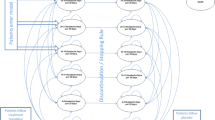Abstract
This report presents the workplace productivity and non-workplace activity results of a multinational study of the effects of subcutaneous sumatriptan 6mg in the acute treatment of migraine compared with patient’s customary therapy.
Patients diagnosed with mIgraine treated their symptoms for 24 weeks with subcutaneous sumatriptan after a 12-week period of treating symptoms with their customary (non-sumatriptan) therapy. Patients used diary cards to record information concerning the effects of migraine on workplace productivity and nonworkplace activity time.
The average workplace productivity time lost was 23.4 hours per patient during 12 weeks of customary therapy, compared with 7.2 and 5.8 hours per patient during the first and second 12-week periods of sumatriptan therapy, respectively. An average of9.3 hours of non-workplace activity time was lost per patient during the customary therapy phase, compared with 3.2 and 2.8 hours during the first and second 12-week periods of sumatriptan therapy, respectively.
Treatment of migraine with subcutaneous sumatriptan compared with customary therapy was associated with an average gain per patient of approximately 16 hours of workplace productivity time and 6 hours of non-workplace activity time, over a 3-month period.
Similar content being viewed by others
References
Solomon GD. Quality-of-life assessment in patients with headache. Pharmaco Economics 1994; 6: 34–41
Osterhaus JT. Townsend RJ. Gandek B. et al. Measuring the functional status and well-being of patients with migraine headache. Headache 1994: 34: 337–43
Dahlof C, Assessment of health-related quality of life in migraine. Cephalalgia 1993: 12: 233–7
Stang PE. Osterhaus JT. Impact of migraine in the United States: data from the National Health Interview Survey. Headache 1993: 33: 29–35
Pryse-Phillips W. Findlay H. Tugwell P. et al. A Canadian population survey on the clinical. epidemiologic, and societal impact of migraine and tension-type headache. Can J Neurol Sci 1992: 19: 313–9
Osterhaus JT. Gullerman DL. Plachetko JR. Health care resource use and lost labour costs of migraine headache in the United States. Pharmaco Economics 1992: 2: 67–76
Clouse JC, Osterhaus JT. Healthcare resource use and costs associated with migraine in a managed healthCare selling. PharomacoE,onomics 1994: 28: 659–64
de Lissomy G. Lazarus SS. The economic cost of migraine: present state of knowledge. Neurology 1994: 44 Suppl.4:58–62
Lipton TB. Stewart WE Health-related quality of life in headache research. Headache 1995: 35: 447–8
Wells NEJ. MioceVich ML. The economic cost of migraine. Br J Med Econ 1992: 2: 103–15
The Suhcutaneous Sumatriptan International Study Group. Treatment of migraine allacks with sumatriptan. N Engl J Med1991: 325: 316–21
Cady RK. Wendt JK. Kirchner JF. el al. Treatment of acute migraine with subcutaneous sumatriptan. JAMA 1991; 265:2831–5
Cutler N. Mushet GR. Davis R. et al. Oral sumatriptan for the acute treatment of migraine: evaluation of three dosagestrengths. Neurology 1995; 45 Suppl.: 10–4
Sergent J. Kirchner JR. Davis R. et al. Oral sumatriptan is effective and welltoleralcd for the a,ute treatment of migraine:results of a multicenter study. Neurology 1995: 45 Suppl.
Rederkh G. Rapoport A. Cutler N. et al. Oral sumatriptan forthe long term treatment of migraine: elini,al lindings. Neurology1995: 45 SuppJ.: 15–20
Heywood J. Bouchard J. Cortelli P. et al. A multinational investigation of the impact of subcutaneous sumatriptan. I: design methods and dinical lindings. Pharmaco Econorni.:s 1997: 11Suppl. 1: 11–23
DahLöF C, Bouchard J. Cortelli P. et al. A multinational investigation of the impa,t of subcutaneous sumatriptan. II: healthrelatedquality of life. PharmacoEwnomi.:s 1997: 11 Suppl.1: 24–34
Bouchard J. Cortelli P. Dahlöf C, et al. A multinational investigation of the impact of subcutaneous sumatriptan.IV: patient satisfaction. Pharmaco Economics 1997: 11 Suppl.1: 43–50
Headache Classilication Committee of the International Headache Society. Classification and diagnostic criteria for headachedisorders. Cranial neuralgias and facial pain. Cephalalgia 1988; 8: 1–96
Mushet GR. Miller IL. Clements B. et al. Impact of sumatriptan on workplace productivity. non work activities, and health-related quality of life among hospital employees with migraine.Headache 1996; 36: 137–43
Dahlöf CGU. How does sumatriptan perform in clinical practise? Cephalalgia 1995: 15 Suppl. 15: 21–8
Rasmussen BK. Jensen R. Scholl M. et al. Epidemiology of headache in a general populmion: a prevalence study. J Clin Epidemiol 1991: 44: 1147–57
van Roijen I. Essink-Bot ML. Koopmanschap MA. et al. Sorietal perspective on the burden of migraine in The Netherlands.Pharmaco Economics 1995: 7: 170–9
Greiner ILL. Addy SN. Sumatriptan use in a large group-model health maintenan,e organisation Am J Health-Syst Pharm1996: 53: 633–8
Miller DW. Martin BC, Loo CM. Sumatriptan and lost productivity: a time series analysis of diary data. Clin Ther 1996: 18:1263–75
Adelman JU. Sharfman M. Johnson R. et al. Impact of oral sumatriptan on workplace productivity. health-related quality of life. healthcare use, and patient satisfaction in nurses with migraine. Am J Managed Care 1996: 2: 1407–16
Author information
Authors and Affiliations
Additional information
Correspondence and reprints: Kim L. Price, Glaxo Wellcome Research and Development, Pharmacoeconomic Research, Greenford Road, Greenford, Middlesex UB6 OHE, England.
On behalf of the Value of Sumatriptan Study Group
Rights and permissions
About this article
Cite this article
Cortelli, P., Dalhlöf, C., Bouclzard, J. et al. A Multinational Investigation of the Impact of Subcutaneous Sumatriptan. Pharmaco economics 11 (Suppl 1), 35–42 (1997). https://doi.org/10.2165/00019053-199700111-00006
Published:
Issue Date:
DOI: https://doi.org/10.2165/00019053-199700111-00006




